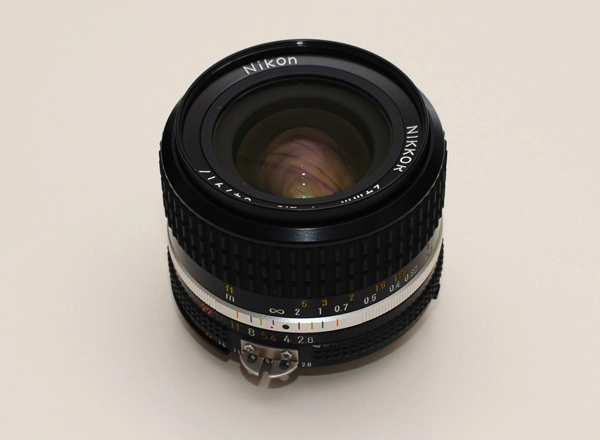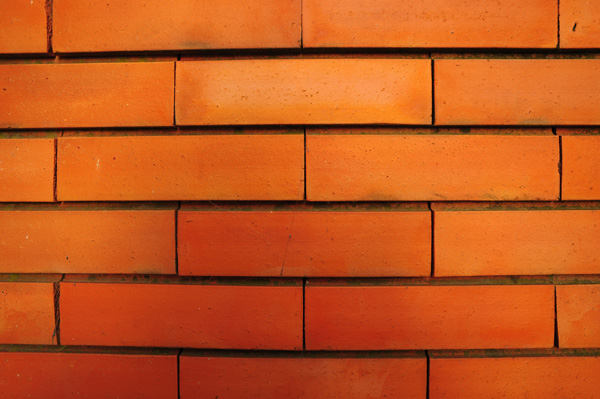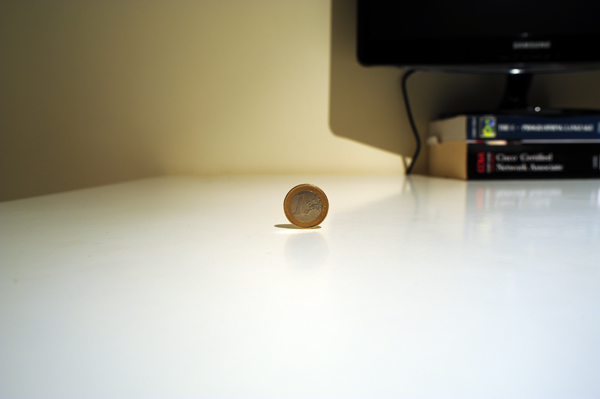Nikon Nikkor 55mm F/12 Non Ai Manual Focus Review
Introduction



This is one of my favourite lenses e'er, the Nikkor 24mm f/2.viii AI-Southward, and here will be tested with the Nikon D700 full-frame DSLR. It'south one of those lenses that may concluding forever and it's a joy to shoot with. Information technology has CRC (close-range correction) for neat performance shooting at shut distances. It's very compact for a wide lens, I tin put it in my jacket's pocket and use information technology in a compression everytime I need to shoot wide.
So allow's start with the size comparison with the D700:


The lens is older than me, it was introduced in 1977 and became a very popular lens then. I had been searching for a nice wide prime to employ on the D700 and this was a approving. It is relatively cheap in the used market today, but some stores are still selling them make new for more than 500€. The AF-D version has the aforementioned optical formula and sells for nearly 430€, but it'due south plastic.
This prime number lens has 9 elements in 9 groups, with a floating element for CRC. The AF-D version has the same optical structure, but information technology'south may not be like shooting fish in a barrel to find a good copy – opinions from other users with this AF-D version are everywhere from stellar to unusable. This lens is a masterpiece of construction like the other Nikkors dorsum in the old days, when everything was metal with engraved markings for aperture and focus altitude.
Used lens prices are everywhere in the range of 180€ to 400€, and that shows how well this lens keeps its value over the years. This is an eternal lens, as long as it'southward free from fungus and doesn't fall of a cliff, of form.
Technical Specifications
| Focal length | 24mm |
| Maximum aperture | f/ii.viii |
| Minimum aperture | f/22 |
| Field of view | 84 degrees (on FX) |
| Weight | 250g |
| Dimensions | 46 x 60mm (48 x 60mm at minimum focus distance) |
| Optical structure | 9 elements in nine groups |
| Aperture blades | vii, straight |
| Filter diameter | 52mm |
| Minimum focus distance | 29cm (20cm from the front chemical element) |
| Hood | HN-1, optional |
| Mountain | AI-S, no CPU |
Mechanical Characteristics
| Zoom band | n/a |
| Focus ring | Metal with rubber finish, with infinity terminate |
| Focus throw | 85 degrees |
| Focus motor | No |
| Optical stabilizer | No |
| Front element rotation while zooming | northward/a |
| Front element rotation while focusing | No |
| Internal focusing | No |
| Lens extension while focusing | Yes, 2mm |
| Lens extension while zooming | n/a |
| Maximum magnification | one:8.viii |
Handling
The lens is dwarfed by the D700, but with a weight of 250g the lens is much heavier than it looks, simply that's the event of using metal everywhere in its construction. Handling the lens is a cakewalk – the focus ring is very big and buttery smoothen (it still is, for a lens with this historic period), and it'due south a joy to utilise. I don't listen using manual focus with wide lenses since focusing is so easy with them, and with the help of the D700's viewfinder it's even easier. The focus ring is finished with a very rough rubber that feels and then great on my fingers, and with a throw of 85 degrees there's a lot of room for precise focus. A great thing this lens has, is that there's a hard end at infinity; when I shoot astrophotography I just turn the focus band around to this hard terminate and that's it, perfect focus on the stars!
The front element doesn't rotate while focusing, so using polarizers is no problem.
Every bit a not-CPU lens, ane has to configure the lens on the D700 as "non-CPU" so it could read whatever aperture value is choosen. The aperture is selected using the discontinuity ring on the lens instead of in-photographic camera, and it doesn't allow to select half-stops or thirds-stops. These are non issues in practice, but the aperture value must be checked from time to time since the aperture ring is non lockable.
Resolution
For the resolution test I shot the 5 Euro bill every bit usual. Focus was achieved using Live View to avoid machine-focus imprecisions and to compensate for possible field curvature problems.
The start cavalcade shows a crop of the epitome heart, the corner ingather is on the second column (the expected DX edge) and the third cavalcade shows a crop of the farthermost FX corner. Each row represents an aperture setting, from maximum to f/22 in full stops. Here are the results:

The center resolution is already on its maximum value, which I honestly wasn't expecting from such old pattern, and but drops a footling bit at f/16 due to diffraction and more and so at f/22. As expected, the corner resolution is much softer overall at f/2.eight, but DX shooters would probably be happy here (await at the second column); FX users will get much worse corners, though. By f/4 the center resolution seems to improve a flake, but what's happened hither is that at f/4 there'south more than light transmission to the sensor, which does brand seem that images are a petty sharper, but they're only clearer. Here, the corners improved a lot, which volition please DX users, and the FX corners were greatly improved as well.
From f/v.6 to f/11 the lens deliverz stunning sharp images both at the center and corners. The sweet spot for FX is from f/8 to f/eleven, the values I typically cull for landscape shots.
Overall, this is very loftier performance for such old wide angle lens, the results are very pleasing and this makes me understand why the lens was then pop back in the days. And today it still rocks.
Distortion
Hither is the brick wall shot:

The lens has a high level of barrel distortion, and FX users will as well take to deal with mustache, giving a wavy shape to horizontal lines, and non only on the summit and lesser of the frame, as you tin can see in sample five at the bottom of the page. The barrel distortion is besides quite visible in existent world shots on vertical lines – just watch the vertical columns on sample three.
In decision, the lens should exist used with caution in compages photography, especially regarding horizontal lines. For landscapes I usually don't worry about information technology, but I always pay attending to the horizon line in seascapes.
Vignetting
In this test, I shot a white wall at dwelling house using tungsten white remainder and set exposure manually:

Vignetting is very strong at f/2.8, that'southward why the resolution test was a bit darker at this setting even in the centre. At f/iv at that place's still considerable vignetting, only it isn't noticeable stopping down once more. With this lens I'd but worry well-nigh vignetting at f/2.viii, simply personally I rarely utilize that setting – only for closeups, and vignetting usually gives a prissy touch.
Chromatic aberrations
For this test I shot a car from above on a bright sunny day early in the afternoon:

I am amazed at how great this lens is controlling CAs. Even at f/2.eight I could non see whatever traces of fringing whatever tests I did. It's perfect.
Coma
Coma was tested using a LED source, at home in a dark room.
I put the light source at the center (first cavalcade), corner and extreme corner of the frame (second and 3rd columns, respectively), at maximum discontinuity and stopped down.

In this matter, the lens disappoints. That's typical for old designs, and still is for the majority of broad bending lenses, and unfortunately this distortion is very noticeable in astrophotography. Forget it if y'all were because this lens for that application and you're a pixel-peeper. I've been using it for that purpose and I try to abstract myself from viewing the borders at 100%.
Flare
I shot a building in structure with the sun sneaking from a window, to run into if I could meet any flare traces. I started to shoot straight against the sunday, then placed the sun at the corner and finally made some shots with the sun simply outside the frame.
 |
| Shot directly against the sun. |
 |
| Shot with the sunday placed at one corner of the frame. |
 |
| Shot with the sunday just exterior the frame. |
The lens has a good resistance to flare and ghosting which keeps contrast intact. The problem is that if the lord's day is in the frame or in the proximity, the internal reflections of light volition be hands visible in the pictures, as tiny as those reflections may exist. Information technology tin be annoying; there were times I thought that the sunday was already at a rubber distance from the frame, and the lens still catched a small grouping of reflections. That can be easily solved in post-processing if those reflections are over a homogen background, but may be distracting and incommunicable to eliminate in textures. Just take a look at the terminal test epitome – these are the reflections I'm talking virtually (wait at the second window hole at the left).
In decision, it is necessary to frame at a rubber distance from the lord's day, and I advise to get the optional HN-ane or use another device to cake reflections definitely.
Bokeh
This is a wide focal lens with vii straight blades, thus bokeh has to be the last matter y'all think about when buying this lens.
I took a defocused picture at the widest aperture of the city lights and got crops of the centre, corner and extreme corners. The test was repeated for the subsequent two stops.

The lens produces a fairly acceptable bokeh after all at f/2.8, although it has onion artifacts and accentuated edges. In real globe shots they're not very distracting, though. Stopping down soon reveals polygonal shapes as a effect of a small-scale number of aperture blades of direct type. That's in line with every ordinary broad angle lenses. For good bokeh there are improve choices such every bit the 24mm f/1.four options (Samyang comes to mind).
Macro/Shut-upwardly
Although the lens is an old design, it has CRC which allows it to focus as close as 20 centimeters from the front element, resulting in a maximum magnification ratio of 1:8.8. It'southward not bad, merely I've seen much better from other wide angle lenses – the Voigländer Color-Skopar 20mm f/iii.5 SL Ii Aspherical, which I also tested, is just ane case, but it's a modern blueprint and a very different ane.
I shot an ane Euro money and this is what to look at the minimum focus distance:

Summary
| Build quality | 10 | All-metallic and very professional, there's nothing to complain about |
| Handling | viii | Fantastic manual focus lens with very rough focus ring, the simply downside is having to select aperture on the lens in total stops |
| Resolution | 9 | Superb resolution for a wide angle lens, only soft in the corners wide-open up and a little at f/4 |
| Distortion | v | Circuitous barrel and mustache baloney, not suitable for architecture |
| Vignetting | 8 | Very strong wide-open, only not noticeable afterward |
| Chromatic aberrations | 10 | This lens reaches perfection here, as did the Voigtländer |
| Blackout | five | Poor, very noticeable in the borders in astrophotography |
| Flare | 8 | Doesn't suffer much and dissimilarity is always on top, but piece of cake to catch a few tiny reflections of calorie-free if y'all're non careful |
| Bokeh | 4 | Acceptable wide-open, simply that's about it |
| Overall | 74% | A very sharp wide bending prime lens that is very pocket-size and very tough, still 1 of the best always that coin can buy |
Samples
Here are some samples of pictures I made with this lens. Settings: native JPEG, motion picture control set to Mural style, no post-processing applied except reducing to 600 pixel width.
 |
 |
 |
 |
 |
 |
nicholsoffeed2000.blogspot.com
Source: https://joserochaphoto.wordpress.com/2012/08/20/nikkor-24mm-f2-8-ai-s-review/
0 Response to "Nikon Nikkor 55mm F/12 Non Ai Manual Focus Review"
Post a Comment